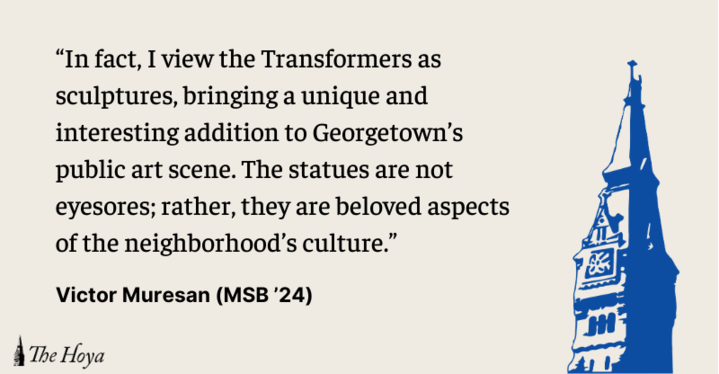The Georgetown community is grappling with a battle over the neighborhood’s iconic Optimus Prime and Bumblebee statues from the Transformers franchise, as the Old Georgetown Board (OGB), a federal commission with jurisdiction over design and aesthetics in Washington, D.C., argues with a homeowner about their appropriate placement. The Transformers have become symbols of the public expression of art and freedom of speech and have garnered mixed reactions within the neighborhood.
The statues stand next to the front entrance of the home of Newton Howard, a professor at Georgetown University who specializes in cognitive science, leaving neighbors and residents displeased. The primary opposition to the statues stems from the OGB, which is tasked with maintaining the uniform, Victorian-esque architectural style of the neighborhood. The Board acts similarly to a homeowners association and has control over exterior architectural features, including the height, appearance, color and texture of the materials of exterior construction.
Although it is important to maintain the overall aesthetic of Georgetown, the Transformers are beloved by the community and are not a distraction from the neighborhood’s architecture. Georgetown students and residents should make their voices heard and sign petitions calling for the OGB to let the Transformers statues stay.
The battle between Howard and the OGB began in 2021. After asking the board for permission to display the Transformers, the OGB determined that the statues did not fit within the historic nature of the Georgetown neighborhood. The standards put in place come from the board of the OGB and their judgment of the situation. In a neighborhood of multimillion-dollar Victorian homes, two towering robots look out of place.
The OGB then gave Howard six months to remove the statues. Instead, he moved the original Optimus Prime to the roof and anchored a new, taller statue to the house’s facade. As a result, city officials urged Howard to reapply for a public spaces permit.
On April 6, the OGB voted unanimously in favor of the statues’ removal, leaving little hope for the fate of Optimus Prime and Bumblebee. One final vote, which will be held April 27, will bring a conclusion to the Georgetown Transformers saga.
One quick search on social media displays numerous posts with the robots and the overwhelming support for keeping them. Students and tourists often take pictures with them, and even after full semesters on campus, it is hard to walk by them without looking and admiring the statues.
However, this social media popularity is key to the anti-Transformers arguments. According to the board, the statues have created disruption on the streets of Georgetown.
Still, it is difficult to reconcile the concept of “disruption” with the Transformers statues that bring new life and creativity to the neighborhood and do not impede majorly with Georgetown’s architectural design and history. The statues are located in front of a single house one block from Georgetown University.
In fact, I view the Transformers as sculptures, bringing a unique and interesting addition to Georgetown’s public art scene. The statues are not eyesores; rather, they are beloved aspects of the neighborhood’s culture.
Georgetown residents have launched a petition to save the sculptures. Thus far, the petition organized by Jordynn Jenkins (CAS ’24) has garnered more than 500 signatures. Signing this petition will show the Public Space Committee, a citywide body that reviews permits and is in charge of shared spaces, how residents and students alike are speaking up on behalf of the Transformers.
The fate of the sculptures remains uncertain, as the community is divided over their place in the neighborhood. The controversy surrounding the Transformers highlights the tension between preserving the historic character of Georgetown and embracing new forms of expression and art.
Art can coexist with history, so students and residents alike must sign the petition to protect the statues.
Victor Muresan is a junior in the School of Business.



















